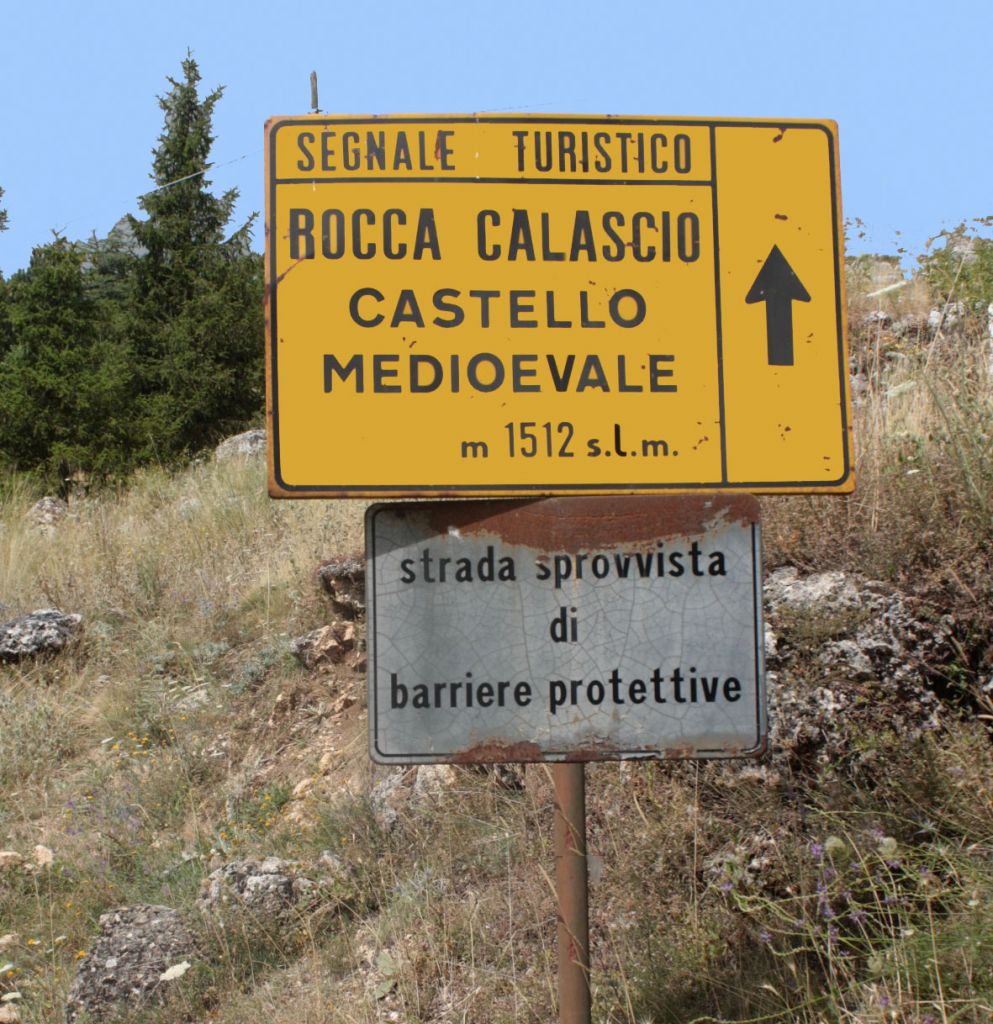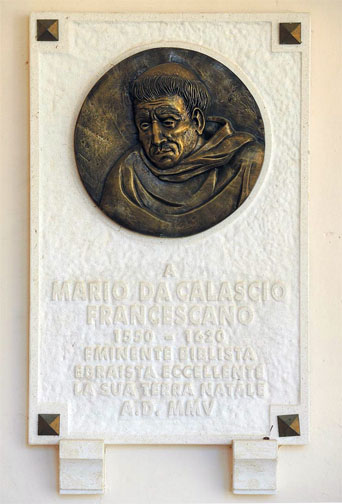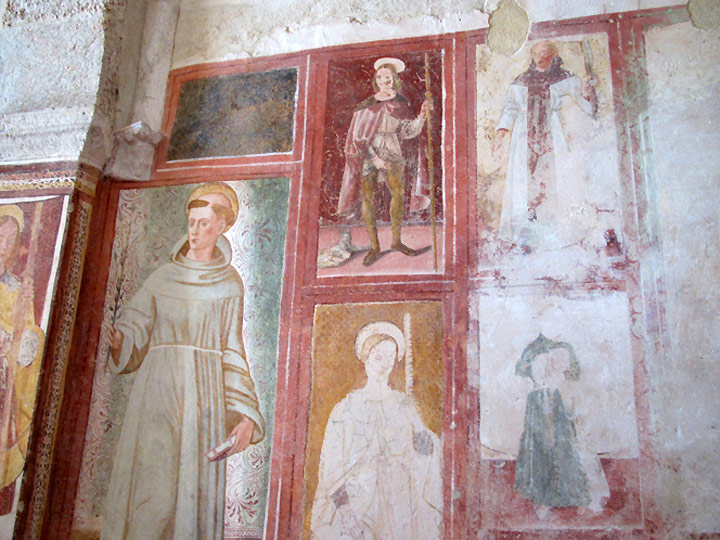A Walk Through Calascio
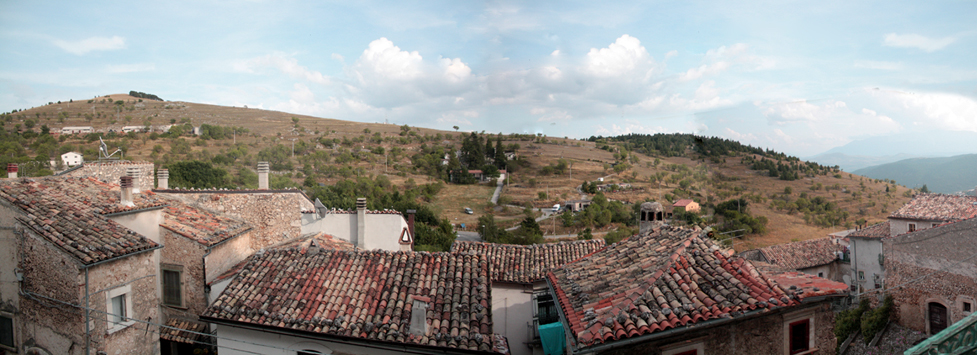
The Italian writer Emidio di Carlo long ago commented about Calascio; “One must cover the village on foot to know it well…explore the contorted and narrow lanes, climb the thousands of steps of the multi-colored flights of stairs whose sunny terraces provide a beautiful show of flowers.” He was correct.
Visiting Calascio involves a great amount of walking. Numerous path ways are made of rugged stone and they are slightly steep so proper shoes (new tennis shoes or thick-soled hiking boots) are suggested. If you require support, bring a walking stick. Calascio is at a high altitude and the air is thin so walking should be done slowly so as to not tire-out quickly. During the summer it is hot and dry; bring a canteen for hydration.
The following walk is just one approach to enjoying the sites in the village. Continue scrolling down this page to begin your walk that will take you from the west end to the east end of Calascio.


WALKING TOUR (Step 1)
Your walk begins at the western end of Calascio in the neighborhood of Coddacchio where the church of St. Anthony the Abbot (San Antonio Abate) was constructed in 1641. This Saint Anthony is the acknowledged founder of monasticism, not to be confused with Saint Anthony of Padua, the revered Franciscan monk who with St. Catherine of Siena, are the two patron saints of Italy. Inside Calascio’s church of San Antonio Abate is an exemplary altar dedicated to the saint and a ceiling adorned with a painting of the Annunciation of the Virgin Mary by the Angel Gabriel. The Abruzzese-born artist Teofilo Patini (1840-1906) created work on the ceiling as well as other works throughout Abruzzo.

WALKING TOUR (Step 2)
Before you begin walking, please face the church of San Antonio Abate and you will see a large stone cross on the ground in front of you. This is an evacuation point for airlifting critically ill residents. With the cross on the ground and with you facing the church, please proceed towards the church and notice (to your right) a stone wall with a plaque that reads, “Belvedere Patrignani”. This wall is named in honor of Carlo Patrignani (1869-1948) an artisan from L’Aquila who restored portions of the the church of San Antonio Abate. He was a student of the above-mentioned Teofilo Patini. Notice the carved stone sunburst on the church façade with the letters “IHS” those are the symbols popularized by Saint Bernardino of Siena (1380-1444), a Franciscan preacher who was devoted to the Holy Name of Jesus. He derived the symbol probably from the first two letters and the final letter of the name “Jesus” as spelled in ancient Greek. Saint Bernardino supposedly preached in Calascio and these markings are seen on other buildings around the village. He died in Aquila and is buried in that city’s Basilica of San Bernardino. While standing in front of the church, also observe the statues of St. Peter and St. Paul along with the etched year “1641” in the far right of the architectural frieze. The date marks the completion of the church building.


WALKING TOUR (Step 3)
Please, face away from the church with your back to it (looking east) to see three pathways offering options for walking into the village. On your left is an upper path along Via Lonardo Antonio Ciotti; there is a middle path called Calatta San Antonio leading downward and a third, lower path to your right that appears to descend into a patch of weeds but this path is Via San Antonio Abate Intra Muros. Calascio.com suggests you take the left, upper path along Via Lonardo Antonio Ciotti to begin your walk into the village.
WALKING TOUR (Step 4)
On Via Lonardo Antonio Ciotti you will see the remains of a home that belonged to the Vespa family. In 1944 during WWII, occupying Nazi soldiers detonated this home in retaliation for the family’s sheltering of escaped British and Australian prisoners of war. The ruins are preserved in memory of that stark period. On the ruins of the home, you should see a stone rectangle street sign for Via Lonardo Antonio Ciotti reassuring you of the correct road.


WALKING TOUR (Step 5)
Follow Via Lonardo Antonio Ciotti past the ruins of the home until you get to a maintained structure followed by a tall house with a stone rectangle plaque that reads, Casa Torre Palmara. Look up to see the tallest structure in the village of Calascio—the five-story la palmara. As you continue down a slight decline in the road, it will merge onto a Y-shaped fork in the path. Proceed to the right and move off Via Lonardo Antonio Ciotti and down the short path on your right called Largo Carnecchia. This is a small open area. On Largo Carnecchia you will see the church of San Antonio Abate in front of you but continue left – walk away from the church– and head down the street that ends at a short side path on your right. As you make your way down the broad stone steps with an iron fence to one side, look right to find a rectangle plaque on a wall. The plaque reads Via Giovanni Domenico Di Marco.
WALKING TOUR (Step 6)
Via Giovanni Domenico Di Marco is a short street, pass through it to make your way onto Via San Antonio Abate Intra Muros where a vista of the valley will be in front of you. Turn left onto Via San Antonio Abate Intra Muros, and now, you are walking east and on your right is the church of San Carlo Borromeo (St. Charles Borromeo 1538-1584) with its oculus on the façade. This church was named for Carlo Borromeo, a Cardinal and the Archbishop of Milan who was an administrator of the third meeting of the Council of Trent. He was declared a saint in 1610. The church was constructed in 1612 at the behest of the Di Marco family who lived in the Codacchio neighborhood nearby and the façade contains their family’s crest. The church is closed and deconsecrated.
WALKING TOUR (Step 7)
With the church of San Carlo in front of you, stay to the left and continue on Via San Antonio Abate Intra Muros allowing you to meander the charming Codacchio neighborhood. After passing the church of San Carlo, you will see Palazzo D’Angelo in front of you at the next fork in the road and here, you’ll want to stay to the left along Via San Antonio Abate Intra Muros as it ascends. Across from Palazzo D’Angelo you will see Palazzo Taranta. Today, the large home is divided into apartments and the front entry serves as Calascio’s town hall situated on the opposite street. This palazzo is a good example of 19th century Neoclassical Italian architecture.
WALKING TOUR (Step 8)
Continue up the incline of Via San Antonio Abate Intra Muros to enter Piazza della Vittoria (Victory Square). Before entering Piazza Vittoria, look left to see the town hall of Calascio. When it is open, the flags of Italy and the EU are displayed outside the entrance. Proceed into Piazza della Vittoria and go directly to the water fountain at its center. The fountain was constructed in 1911 to bring the first dependable flow of artesian water into the village for free pubic use.



WALKING TOUR (Step 9)
Piazza della Vittoria was named in honor of the WWI allied victory and it contains two war memorials honoring soldiers from Calascio who perished during WWI and WWII. The focal point of this piazza is the parish church of San Nicola di Bari (St. Nicholas of Bari, 270-343), patron saint of Calascio and to several other villages of the region. This Saint Nicholas became the model for Santa Claus. The parish was constructed in 1537 and its entrance is adorned with the crest of the Piccolomini family of Siena.

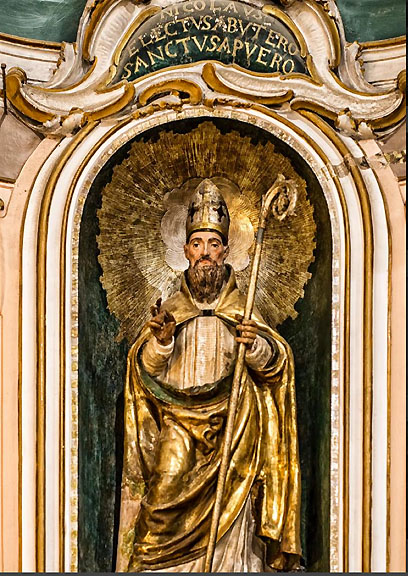
WALKING TOUR (Step 10)
Piazza Vittoria contains la vecchia fucina (the old forge) used by a branch of the Frasca family who for centuries were Calascio’s leading ironsmiths. The forge, coated in black ash, is right of the fountain and to the right of the forge-- see a long, main street that runs through the middle of the village. This is Via di Mezzo la Terra (Middle Ground Street). The rectangular building with an arched door facing the piazza (just on the left side of Via di Mezzo la Terra) is Palazzo Frasca (Frasca mansion) the 19th century residence of Luigi Frasca (1858-1933), a mayor and a benefactor of the village. The crest of his family is visible above the door facing the piazza.



WALKING TOUR (Step 11)
Proceed towards the arched door of Palazzo Frasca but then, pass to the right of it (walking east) to follow Via di Mezzo la Terra. You will know you are on the correct street when you see a white plastered wall on your right, across from Palazzo Frasca. This wall contains interesting war-related graffiti, like the “W” sign indicating an Italian dóppia vu for “long live”. During WWII the “W” letter was synonymous with the “V” for victory sign used by allied armed forces. As you walk east on the long and narrow Via di Mezzo la Terra you will arrive at an open space, Piazzetta dell’Altera (Plaza of Altars). On your right is a former rectory for Calascio’s priests. Today, this tan stone building is vacant but the façade has a plaque honoring Monsignor Giovanni Giallonardo (1912-2007) who served as head priest of the parish church from 1938 until his death.



WALKING TOUR (Step 12)
After passing Piazzetta dell’Altera you continue walking east on Via di Mezzo la Terra where you will see on your right the 16th century Palazzo Fulgenzi (Fulgenzi mansion) indicating you have reached the neighborhood of Ammoglia, the eastern terminus of Via di Mezzo la Terra. Ammoglia neighborhood also contains the salmon-colored Palazzo Volpe-Sabucchi and the former convento (Franciscan residence). The convento was constructed in 1594 by the Franciscan order and was largely paid for by gifts from Pope Paul V in support of his Confessor and friend, Padre Mario da Calascio, a locally born Franciscan. The neighborhood is also home to the church of Santa Maria delle Grazie (Saint Mary of the Graces) with its three-arched façade and beautiful, baroque-styled interior.



WALKING TOUR (Step 13)
Walking past (and to the rear) of Santa Maria delle Grazie, continue east beyond Via di Mezzo la Terra and walk past the convent. At this point, the street becomes Viale Vincenzo De Bartholomaeis and following this street will lead you to the oldest standing church in Calascio, La Cappella di San Leonardo (the Chapel of St. Leonard). It was built to honor St. Leonard of Noblac (? – 559), a hermit whose following grew to cult status throughout Europe during the twelfth century. The center part of the chapel was built in 1263 but the structure fell into disrepair after the plagues and the Abruzzo earthquake of 1703. Its side editions were added centuries later. While restoration projects preserved the primitive frescos inside, La Cappella di San Leonardo remains closed to visitors and is opened on occasion only during the August vacation season.


WALKING TOUR (Finishing Point)
Continue east and walk away from San Leonardo chapel on the road of Vincenzo De Bartholomaeis. This will lead you to a grassy park surrounded by a fence. Inside the park are picnic tables and a rectangle plaque dedicated to Don Giovanni Minozzi, (1884-1959), a Catholic priest who founded the religious order Opera Nazionale per Il Mezzogiorno d’Italia also referred to as Famiglia dei Discepoli (Family of the Disciples). In years past, the order cared for children orphaned by war.
You can return to the village by turning right at the Y fork in the road outside the park. The road curves right, so just follow the street signs into the village and you will merge onto Via XXIV Maggio, Calascio’s main street with its two cafés. Should you instead decide to turn left at the fork in the road next to the park, the path ascends above the village 4,790 ft. (1,460 meters) to La Rocca di Calascio (the fortress of Calascio). Calascio.com highly recommends walking to La Rocca in order to complete your experience in the village. Enjoy your visit!


